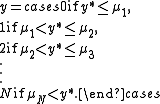
Ordered logit
Encyclopedia
In statistics
, the ordered logit model (also ordered logistic regression or proportional odds model), is a regression
model for ordinal dependent variables. It can be thought of as an extension of the logistic regression
model for dichotomous dependent variables, allowing for more than two (ordered) response categories.
The model only applies to data that meet the proportional odds assumption, that the relationship between any two pairs of outcome groups is statistically the same. This means that
The model cannot be consistently estimated using ordinary least squares
; it is usually estimated using maximum likelihood
.
Examples of multiple ordered response categories include bond ratings, opinion surveys with responses ranging from "strongly agree" to "strongly disagree," levels of state spending on government programs (high, medium, or low), the level of insurance coverage chosen (none, partial, or full), and employment status (not employed, employed part time, or fully employed).
Suppose the underlying process to be characterized is
 ,
,
where y* is the exact but unobserved dependent variable (perhaps the exact level of agreement with the statement proposed by the pollster); x is the vector of independent variables, and is the vector of regression coefficients which we wish to estimate. Further suppose that while we cannot observe y*, we instead can only observe the categories of response
is the vector of regression coefficients which we wish to estimate. Further suppose that while we cannot observe y*, we instead can only observe the categories of response

Then the ordered logit technique will use the observations on y, which are a form of censored data
on y*, to fit the parameter vector .
.
Statistics
Statistics is the study of the collection, organization, analysis, and interpretation of data. It deals with all aspects of this, including the planning of data collection in terms of the design of surveys and experiments....
, the ordered logit model (also ordered logistic regression or proportional odds model), is a regression
Regression analysis
In statistics, regression analysis includes many techniques for modeling and analyzing several variables, when the focus is on the relationship between a dependent variable and one or more independent variables...
model for ordinal dependent variables. It can be thought of as an extension of the logistic regression
Logistic regression
In statistics, logistic regression is used for prediction of the probability of occurrence of an event by fitting data to a logit function logistic curve. It is a generalized linear model used for binomial regression...
model for dichotomous dependent variables, allowing for more than two (ordered) response categories.
The model only applies to data that meet the proportional odds assumption, that the relationship between any two pairs of outcome groups is statistically the same. This means that
- the coefficients that describe the relationship between, say, the lowest versus all higher categories of the response variable are the same as those that describe the relationship between the next lowest category and all higher categories, etc....Because the relationship between all pairs of groups is the same, there is only one set of coefficients.
The model cannot be consistently estimated using ordinary least squares
Ordinary least squares
In statistics, ordinary least squares or linear least squares is a method for estimating the unknown parameters in a linear regression model. This method minimizes the sum of squared vertical distances between the observed responses in the dataset and the responses predicted by the linear...
; it is usually estimated using maximum likelihood
Maximum likelihood
In statistics, maximum-likelihood estimation is a method of estimating the parameters of a statistical model. When applied to a data set and given a statistical model, maximum-likelihood estimation provides estimates for the model's parameters....
.
Examples of multiple ordered response categories include bond ratings, opinion surveys with responses ranging from "strongly agree" to "strongly disagree," levels of state spending on government programs (high, medium, or low), the level of insurance coverage chosen (none, partial, or full), and employment status (not employed, employed part time, or fully employed).
Suppose the underlying process to be characterized is
 ,
,where y* is the exact but unobserved dependent variable (perhaps the exact level of agreement with the statement proposed by the pollster); x is the vector of independent variables, and
 is the vector of regression coefficients which we wish to estimate. Further suppose that while we cannot observe y*, we instead can only observe the categories of response
is the vector of regression coefficients which we wish to estimate. Further suppose that while we cannot observe y*, we instead can only observe the categories of response
Then the ordered logit technique will use the observations on y, which are a form of censored data
Censoring (statistics)
In statistics, engineering, and medical research, censoring occurs when the value of a measurement or observation is only partially known.For example, suppose a study is conducted to measure the impact of a drug on mortality. In such a study, it may be known that an individual's age at death is at...
on y*, to fit the parameter vector
 .
.

